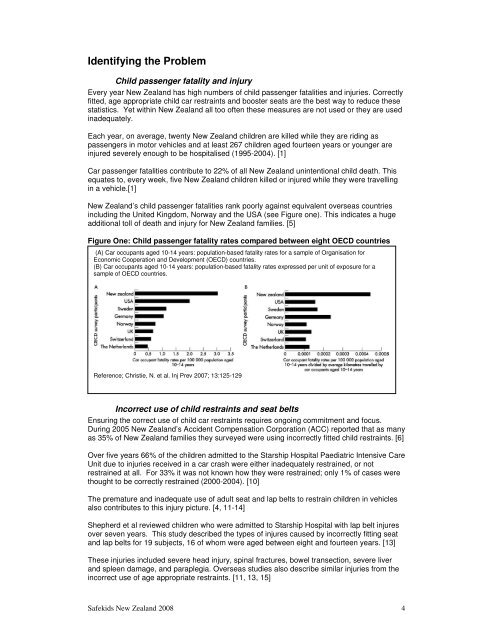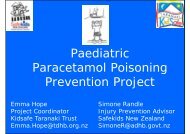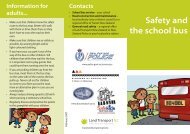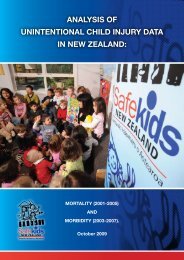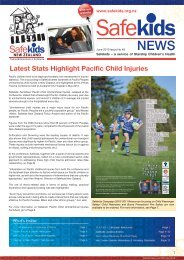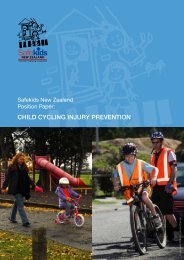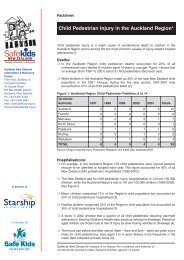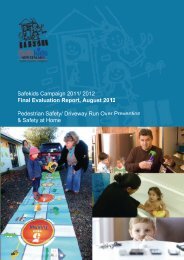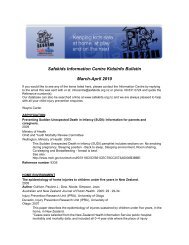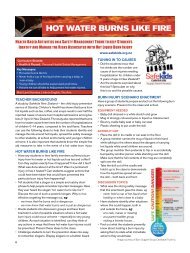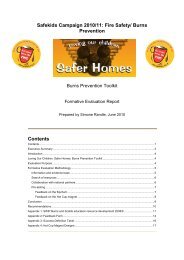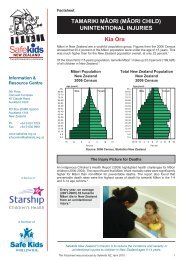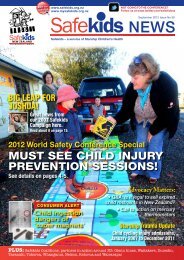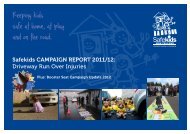Summary It's booster seat time for Kiwi kids - Safekids
Summary It's booster seat time for Kiwi kids - Safekids
Summary It's booster seat time for Kiwi kids - Safekids
Create successful ePaper yourself
Turn your PDF publications into a flip-book with our unique Google optimized e-Paper software.
Identifying the Problem<br />
Child passenger fatality and injury<br />
Every year New Zealand has high numbers of child passenger fatalities and injuries. Correctly<br />
fitted, age appropriate child car restraints and <strong>booster</strong> <strong>seat</strong>s are the best way to reduce these<br />
statistics. Yet within New Zealand all too often these measures are not used or they are used<br />
inadequately.<br />
Each year, on average, twenty New Zealand children are killed while they are riding as<br />
passengers in motor vehicles and at least 267 children aged fourteen years or younger are<br />
injured severely enough to be hospitalised (1995-2004). [1]<br />
Car passenger fatalities contribute to 22% of all New Zealand unintentional child death. This<br />
equates to, every week, five New Zealand children killed or injured while they were travelling<br />
in a vehicle.[1]<br />
New Zealand’s child passenger fatalities rank poorly against equivalent overseas countries<br />
including the United Kingdom, Norway and the USA (see Figure one). This indicates a huge<br />
additional toll of death and injury <strong>for</strong> New Zealand families. [5]<br />
Figure One: Child passenger fatality rates compared between eight OECD countries<br />
(A) Car occupants aged 10-14 years: population-based fatality rates <strong>for</strong> a sample of Organisation <strong>for</strong><br />
Economic Cooperation and Development (OECD) countries.<br />
(B) Car occupants aged 10-14 years: population-based fatality rates expressed per unit of exposure <strong>for</strong> a<br />
sample of OECD countries.<br />
Reference; Christie, N. et al. Inj Prev 2007; 13:125-129<br />
Incorrect use of child restraints and <strong>seat</strong> belts<br />
Ensuring the correct use of child car restraints requires ongoing commitment and focus.<br />
During 2005 New Zealand’s Accident Compensation Corporation (ACC) reported that as many<br />
as 35% of New Zealand families they surveyed were using incorrectly fitted child restraints. [6]<br />
Over five years 66% of the children admitted to the Starship Hospital Paediatric Intensive Care<br />
Unit due to injuries received in a car crash were either inadequately restrained, or not<br />
restrained at all. For 33% it was not known how they were restrained; only 1% of cases were<br />
thought to be correctly restrained (2000-2004). [10]<br />
The premature and inadequate use of adult <strong>seat</strong> and lap belts to restrain children in vehicles<br />
also contributes to this injury picture. [4, 11-14]<br />
Shepherd et al reviewed children who were admitted to Starship Hospital with lap belt injures<br />
over seven years. This study described the types of injures caused by incorrectly fitting <strong>seat</strong><br />
and lap belts <strong>for</strong> 19 subjects, 16 of whom were aged between eight and fourteen years. [13]<br />
These injuries included severe head injury, spinal fractures, bowel transection, severe liver<br />
and spleen damage, and paraplegia. Overseas studies also describe similar injuries from the<br />
incorrect use of age appropriate restraints. [11, 13, 15]<br />
Safe<strong>kids</strong> New Zealand 2008 4


